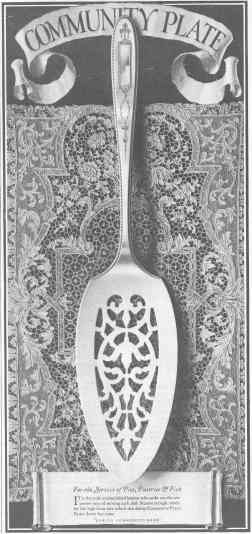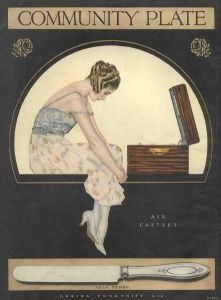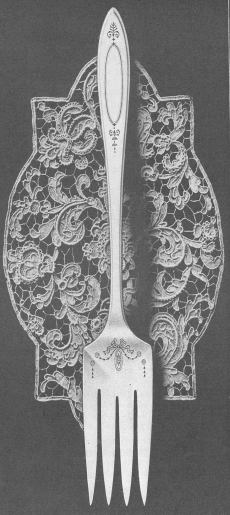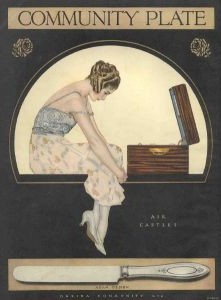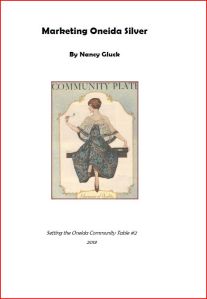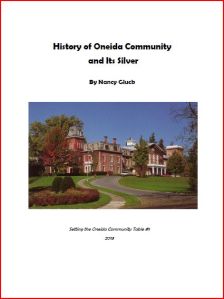 I have been reading The Days of My Youth: A Childhood Memoir of Life in the Oneida Community by Corinna Ackley Noyes. Corinna’s grandparents and parents were early members of the utopian community of Perfectionists at Oneida, New York, founded by John Humphrey Noyes in the 1840s. She was born there and lived there as a “child of the community” until its breakup in 1880. She went on to marry Pierrepont Noyes, one of the sons of the founder. Pierrepont Noyes led Oneida Community Ltd., the corporation formed when the utopian experiment ended, to a successful place in America’s 19th and early 20th century silver industry.
I have been reading The Days of My Youth: A Childhood Memoir of Life in the Oneida Community by Corinna Ackley Noyes. Corinna’s grandparents and parents were early members of the utopian community of Perfectionists at Oneida, New York, founded by John Humphrey Noyes in the 1840s. She was born there and lived there as a “child of the community” until its breakup in 1880. She went on to marry Pierrepont Noyes, one of the sons of the founder. Pierrepont Noyes led Oneida Community Ltd., the corporation formed when the utopian experiment ended, to a successful place in America’s 19th and early 20th century silver industry.
Oneida Community had a branch at Wallingford, Connecticut. It was in Wallingford that the community first began to manufacture spoons, a process which was later transferred to Niagara Falls, New York. Corinna’s first memories of Wallingford were of a trip there by train and boat in early childhood and a candy rose given to her before the trip. She showed it to the other children,
…one bold spirit blustered out, “But, aren’t you going to share?”
“Oh,” I said,” It’s too pretty to eat. This was not at all the general sentiment, and my remark was met by silence and sour looks. Then a bright thought struck one of the children. “Couldn’t we just lick the back of it? It wouldn’t hurt it.” Our moths were all watering by that time and it seemed quite feasible, so I unwrapped my rose and passed it around, dire apprehension in my hear. Those licks were long and loving but by the time it reached me I couldn’t see that the lovely rose has suffered. It was just as pink and perfect as when I got it, so I dared to take my turn at licking….
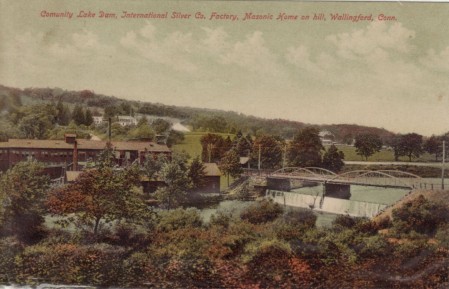
Memories of another visit to Wallingford explain what is shown on an early 20th century postcard above.
Malaria, which followed the enlarging of the pond to provide water power for the spoon factory, as it was called, had taken a heavy toll of the Wallingford family…. The spoon business was to be moved to Niagara Falls and the Wallingford factory was sold to Maltby, Stevens & Curtis of Meriden, Conn.
The postcard bears the inscription “Community Lake Dam, International Silver Co. Factory, Masonic Home on hill, Wallingford, Conn.” Maltby, Stevens as acquired and became part of International Silver at the time of the big merger in 1898, so when the postcard was made the factory building shown on the left had become part of International Silver. The lake was known as Community Lake then and still is. The original dam is gone, replaced by an earthen dike. The road, Hall Avenue, is in the same location, but the waterfall is gone. International Silver is also gone, and the building is currently being used by Amphenol Corporation. A map of the Wallingford location shows the relationship of the building (A) and the somewhat-altered lake.
 On the postcard, you can see the Masonic Home on the hill above the lake and factory. Today’s map shows the Masonicare Health Center on this site. Corinna explains,
On the postcard, you can see the Masonic Home on the hill above the lake and factory. Today’s map shows the Masonicare Health Center on this site. Corinna explains,
It only remains for me to tell of the final end of the Wallingford Community buildings. They were large enough to accommodate a family of fifty, by no means beautiful and not easy to sell advantageously…. Not until two years later was a satisfactory offer made. This came from the Freemasons who wanted it for a home for their aged members. They would also have use for the farm, so it was sold to them and is still used by them [in 1960] for this purpose, thus maintaining its original purpose – a communal home.
The retirement facility for the Masons is still in Wallingford, but is now west of its original location, which is now occupied by their health center.
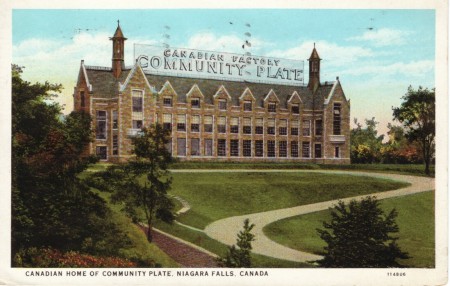 Corinna’s memoir has, incidentally, explained the appearance of another postcard: the factory in Niagara Falls, Canada. As you can see the building has a sign “Canadian Factory / Community Plate,” but I had a hard time accepting that this was a factory building. Surely, this is the executive office and “the works” are out in back. Not so.
Corinna’s memoir has, incidentally, explained the appearance of another postcard: the factory in Niagara Falls, Canada. As you can see the building has a sign “Canadian Factory / Community Plate,” but I had a hard time accepting that this was a factory building. Surely, this is the executive office and “the works” are out in back. Not so.
That factory, built in 1925, looks more like a college building than a commercial plant. To me it is a joy to behold, on its terraced hill surrounded by flowering shrubs and gardens with the breath-taking grandeur of the falls always in view, a place for inspiration, a place to dream dreams.
When I visited the Shaker village in Kentucky, our guide pointed out that the workshops were as well constructed, as airy and well-lighted and pleasant as the living quarters. Work is honored with “A place to dream dreams.” Today we are short on such dreams, but the descendants of the Perfectionists understood our need for them.
For more about the Oneida Community, its history and products, click here.

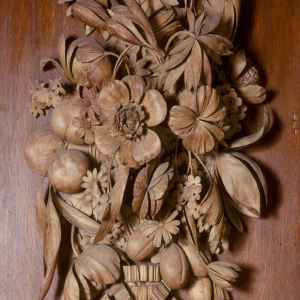



 Posted by SilverSeason
Posted by SilverSeason 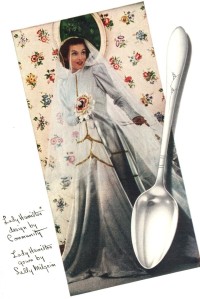
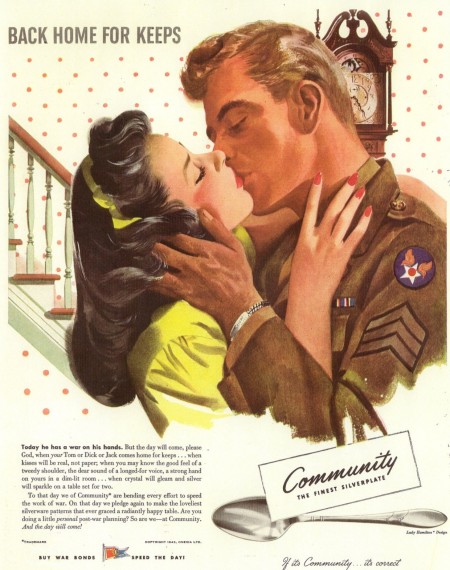
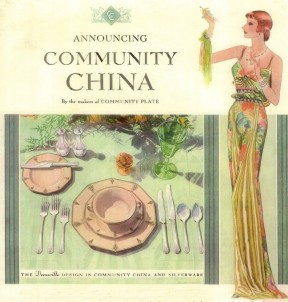
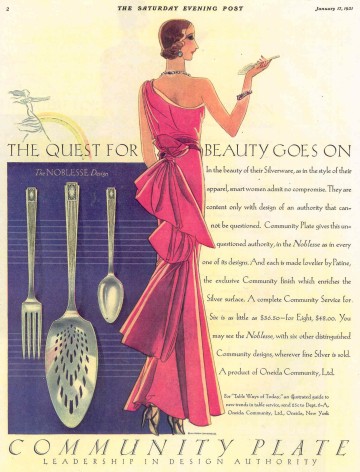
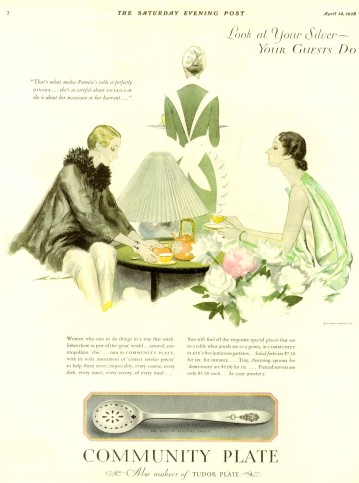
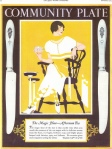
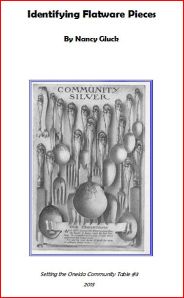
 In addition, a comprehensive index of Flatware Names and Measurements lists all the pieces described, with alternate names and usual measurements.
In addition, a comprehensive index of Flatware Names and Measurements lists all the pieces described, with alternate names and usual measurements.





